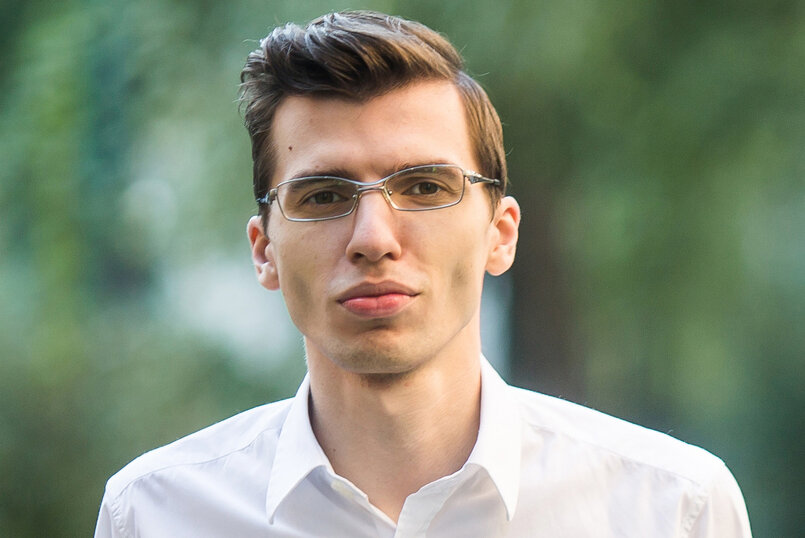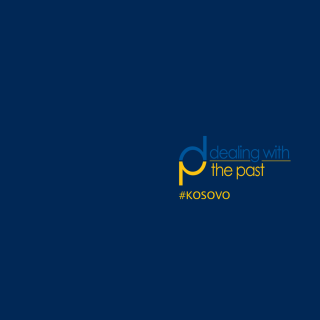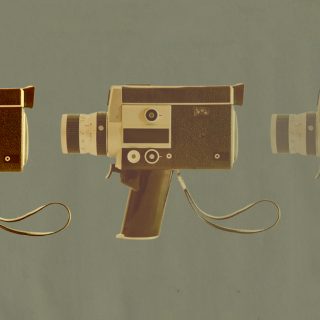I went to Kyiv for first time in 2015. There was no special reason for it. I love to travel. Ukraine was the only country in Europe that I had not visited yet. I found a cheap ticket, and a cheap room near the main square. During that trip, nothing particularly special happened to me. Yet, in those seven days I spent in Kyiv, Ukraine became the favourite country I had ever visited. It still is to this day, and I have travelled to 88 countries.
I grew up in occupied Sarajevo. I was born in 1988, so some of the most important years of my childhood – fifth, sixth, seventh and partly eighth – were spent in the war. I consider myself privileged because I did not lose anyone from my immediate family, and I survived without any injuries. However, the war greatly affected my childhood and went on to define my life. I spent the rest of my childhood in a demolished city, which was slowly and painfully rebuilt. Window by window, street by street, building by building, park by park. I remember when they finally placed a new slide and swing set in the park next to my building. I watched from my window a line of children, more than fifty meters long. Some things could be renewed. Only a year after the war ended, we went back to our rebuilt school, which was refurbished thanks to the Government of Japan, I believe. Some things were more difficult, like people’s health and moods. People who had lost someone, or had become refugees, like my Nana, had a tough time getting used to the post-war life rhythm, to their new surroundings, to the new circumstances.
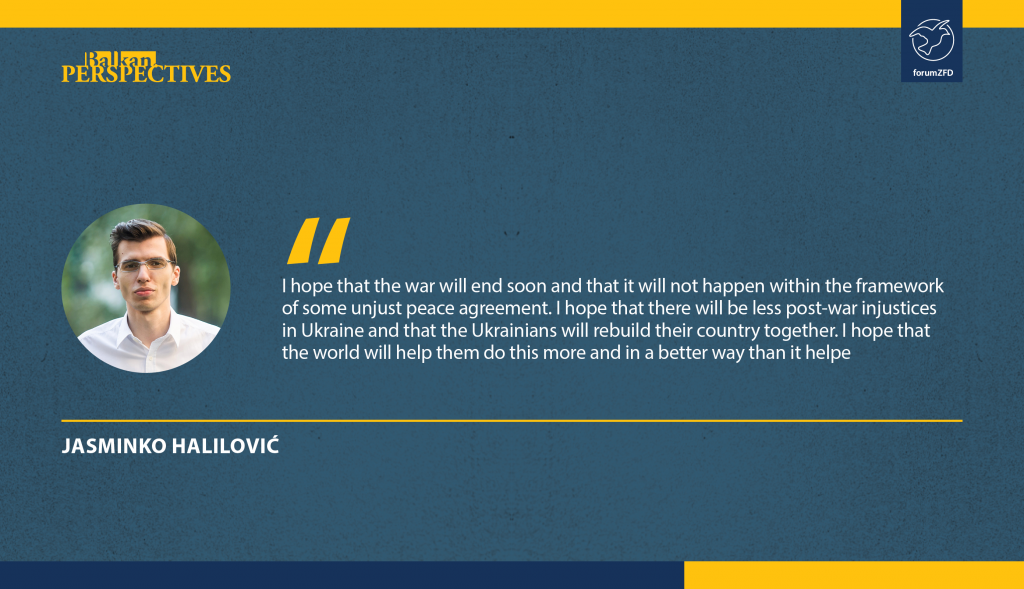
The year when the war had just ended, I was in second grade, and my sister was born. She is a neuroscientist now, and her work brings her all over the world. Already many years have passed since the war. The same year when the war ended, my friend Saudin was demobilized after four years in the army. He was 22 years old, with ten Deutsche Marks in his pocket, and several T-shirts. After four years of direct combat, killing enemy soldiers and walking over the bodies of his friends, Saudin now roamed the streets of Sarajevo and was supposed to continue living a normal life. He never finished high school because the war had started when he was a senior. He found himself in a city where he had almost no-one. That is how it goes after every war. Some begin their lives, some are lost, some lives will go on, and some will be a struggle to continue.
When Sarajevo was being systematically destroyed from the surrounding hills during the nineties, the city was full of international journalists risking their lives to show the world, especially the Western world, what was happening here. The world did not care all that much. Was it because the values were different in that world than they are today, or was it because the people here are mostly Muslim? It is hard to say. The former is less probable, but it is what I would like to believe. The latter is more probable, but not easy to accept. Decision-makers and leaders did not rush to take photos with Bosnian flags, nor did they send us money and weapons. Our lives were not acknowledged as worthy enough for their interests. One of the few decision-makers who spoke in Bosnia and visited Bosnia was the then American senator Joe Biden. For us, it was already too late. Tens of thousands of lives had already been lost, hundreds of thousands lives destroyed, millions of lives damaged. But better late than never, right – or not? Anyways, the historians of the future will be the judges of that.
When the war ended I continued with my education, and I started a business while still in high school. At the same time, I began working a bit in cultural production as a hobby. Writing, publishing, and editing remained my interests during and after the University. Several books and projects later, all connected to Sarajevo, I decided in 2010 to put together a book about my generation’s experience growing up in the war. Thinking about what kind of book it should be, I concluded fairly quickly that it should not focus on my personal experience. I decided to collect memories via the Internet and publish them in the book. To make room for as many of us who were children during the war as possible, I limited everyone’s submission to 160 characters, like a text message. More than a thousand people responded. Following a childhood spent in war that defined my early youth, this book marked the beginning of a project on the childhood that later defined entirely my adult life. Many who submitted their memories for the book began sending me other things: scanned diaries, letters, drawings, photos of personal objects connected to their memories. I got to thinking how impossible it would be to publish all of that in one book. That is how I realized the need of people to speak out about this issue, about their personal experiences. I pondered what else I could do in addition to the book, to keep that space permanently open. Thus, in 2012, before the book was published, I came up with the idea to start a War Childhood Museum, and I wrote its first concept.
After the book was published, I returned to that idea in 2014, thinking about establishing the War Childhood Museum. The same year when the Maidan Revolution happened and the war in Eastern Ukraine started, I decided to start working on the Museum. I put together a team, we developed a methodology, then a collection, created exhibitions, and opened a permanent exhibition in 2017. We received international museum awards, and finally started working outside of Bosnia and Herzegovina. One of the first places outside of our home country that we worked at was Ukraine, where I met activist Olena Rozvadovska, in 2018. Olena left her life in Kyiv and moved to Eastern Ukraine to work with children on the front line.
I remember riding with Olena in her old, worn-down car. We almost flew over demolished roads along the front line. She showed me where the attacks had taken place, and what had remained standing afterwards. We slipped through several checkpoints and came to a small village called Zajcevo. Olena was renovating a room in the destroyed school building, where she would hold workshops for children. We spent a few days together, and we knew we had to do something together. Soon, Olena arrived in Sarajevo for a training programme. After that, she began collecting stories in Eastern Ukraine and exhibits for the collection of the War Childhood Museum.
Two years later, in 2020, the Museum opened its Kyiv office, with the support of the German peace organization forumZFD. Our team grew to ten people, and our activities became more numerous. We did everything regarding children and young people whose childhoods were affected by the war in Eastern Ukraine, whether they still lived there or had already been displaced throughout this great, wonderful country. Over the years, the presence of the War Childhood Museum in Ukraine and my connection with that country became stronger. Finally, in 2021, we started exhibiting in Kyiv, and in early February 2022, we closed the exhibition in Kherson, in the south of the country.
In February 2022 I was on vacation in Australia. That was when the former Senator who advocated for help for Bosnia, and now the President of the United States, Joe Biden, started to announce the Russian attack on Ukraine. We thought that it was impossible, we did not want to believe it. I was in touch with friends, our team, and everything seemed like it would not actually happen. The US was persistent in announcing it, others were joining them, and the pressure was growing each day. On February 15th I decided to leave for Kyiv. The city was full of war journalists. They were ready to do what they did best – to report on the war.
Kyiv was as beautiful as ever: people were buying flowers, theatre tickets were sold out, musicians were playing on the streets, cafés and restaurants were full. If someone had only looked around and not listened to the conversations, nothing would have seemed out of the ordinary. But every conversation was already about the war. People had their bags packed, backpacks with documents, cars full of gas waiting in their garages. It was stressful living and sleeping those days in Kyiv and in Ukraine. The leading politicians in the world kept announcing the war every evening and millions of people went to bed trying to get a good night’s sleep.
I saw my friends, helped our team finalize the evacuation plan, spoke to foreign journalists and diplomats. Some of them were certain that Kyiv would fall in two days. I disagreed because that was contrary to everything I was hearing from my friends: everyone was determined and ready to defend their city. I left Kyiv on February 20th with a suitcase full of exhibits. Flights were slowly being cancelled, the pressure was growing, it was clear that the war would begin.
The whole world followed what happened later, so I will not go into it. I came back to Bosnia and talked in the media about the situation in Ukraine, which the whole world was following. And then the invasion happened and the citizens of Sarajevo and of other cities in Bosnia and Herzegovina went out into the streets to protest for peace. The Sarajevo City Hall was painted in the colours of the Ukrainian flag. I talked to people, they sent their love to the Ukrainians, donated money, sent messages of support. Some of them were afraid that the war could somehow spread to the Western Balkans. Most were re-traumatized by the images from Ukraine, which reminded all of us of our war. Europe reacted differently than it had with Bosnia; this time, it was united and quite determined. They sent weapons to Ukraine, and every other kind of help, they understood that Ukraine was not defending only itself.
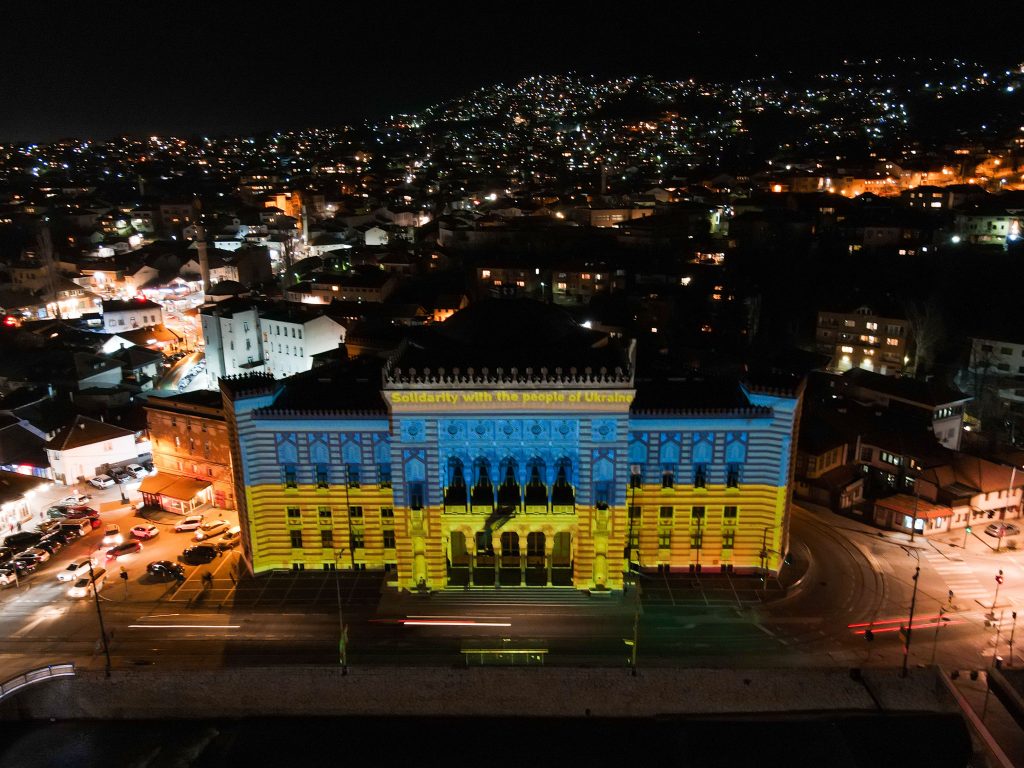
At the time of writing this article, it has been more than three months since the beginning of the war, and many people are going back to Kyiv. I am also getting ready for my first visit to my favourite city. Kyiv was, as I expected, defended, and unlike Sarajevo, which was also defended, luckily not completely demolished. The infrastructure will be renewed or rebuilt. People will be different. There are babies being born in Ukraine now who will become scientists in thirty years. One day the war will end, and there will be veterans, many of them only twenty years old, expected to continue living “normal lives”. Some will come out of the war with nothing, a backpack and several T-shirts. Decades will pass until their wounds heal, and some might never heal.
I hope that the war will end soon and that it will not happen within the framework of some unjust peace agreement. I hope that there will be less post-war injustices in Ukraine and that the Ukrainians will rebuild their country together. I hope that the world will help them do this more and in a better way than it helped us. And I hope that one day the War Childhood Museum will be opened in Kyiv, that it will forever preserve and tell the stories of all the children whose childhoods were marked by this brutal, mindless invasion.
Jasminko Halilović is the founder and Director of the War Childhood Museum in Sarajevo. He is the author and editor of several books, including Childhood at War, which has been translated into six languages. As a guest lecturer, he has spoken at leading universities and conferences in more than fifteen countries. He is the first Bosnian to be selected in the Forbes’ list “30 under 30”.
